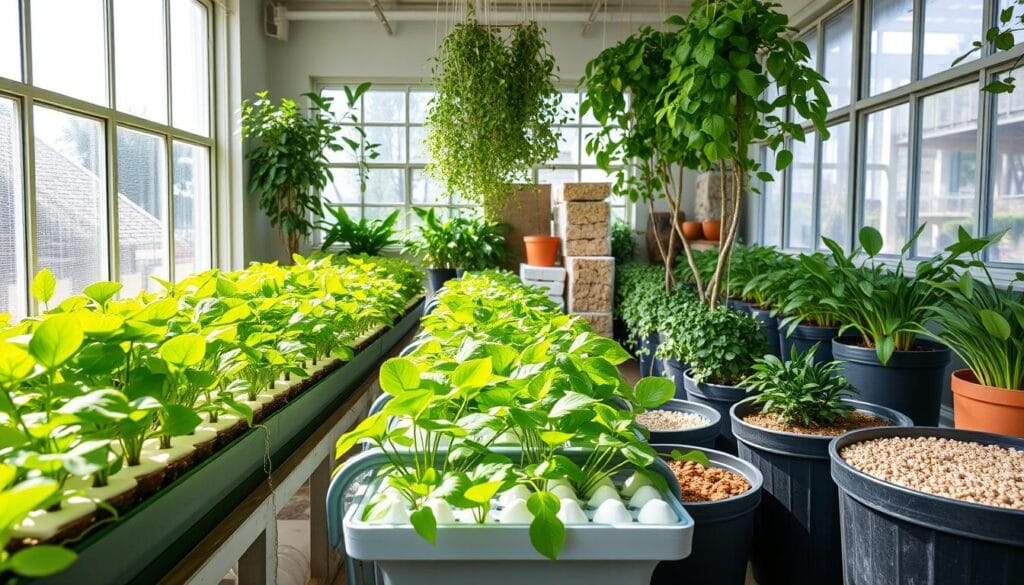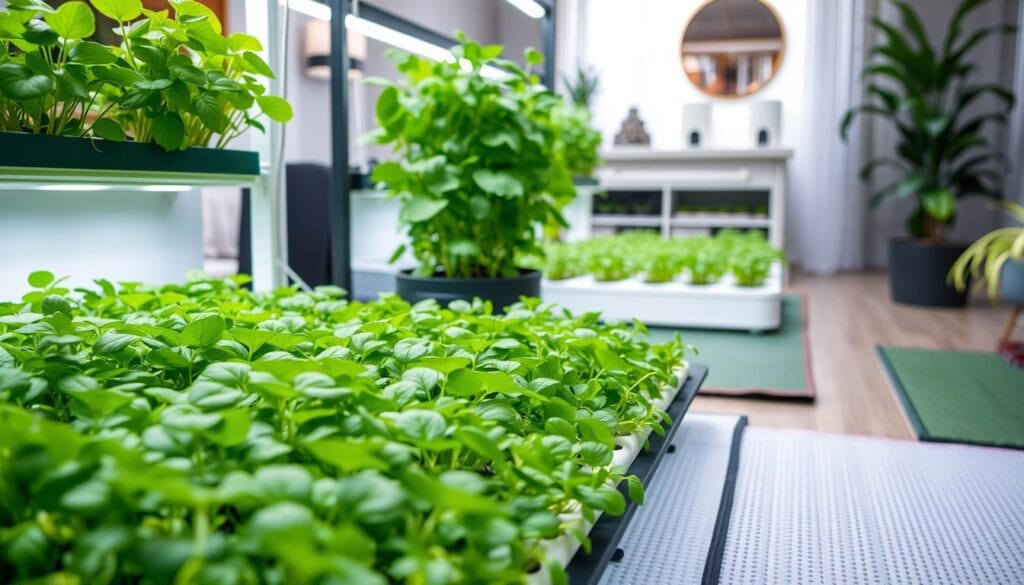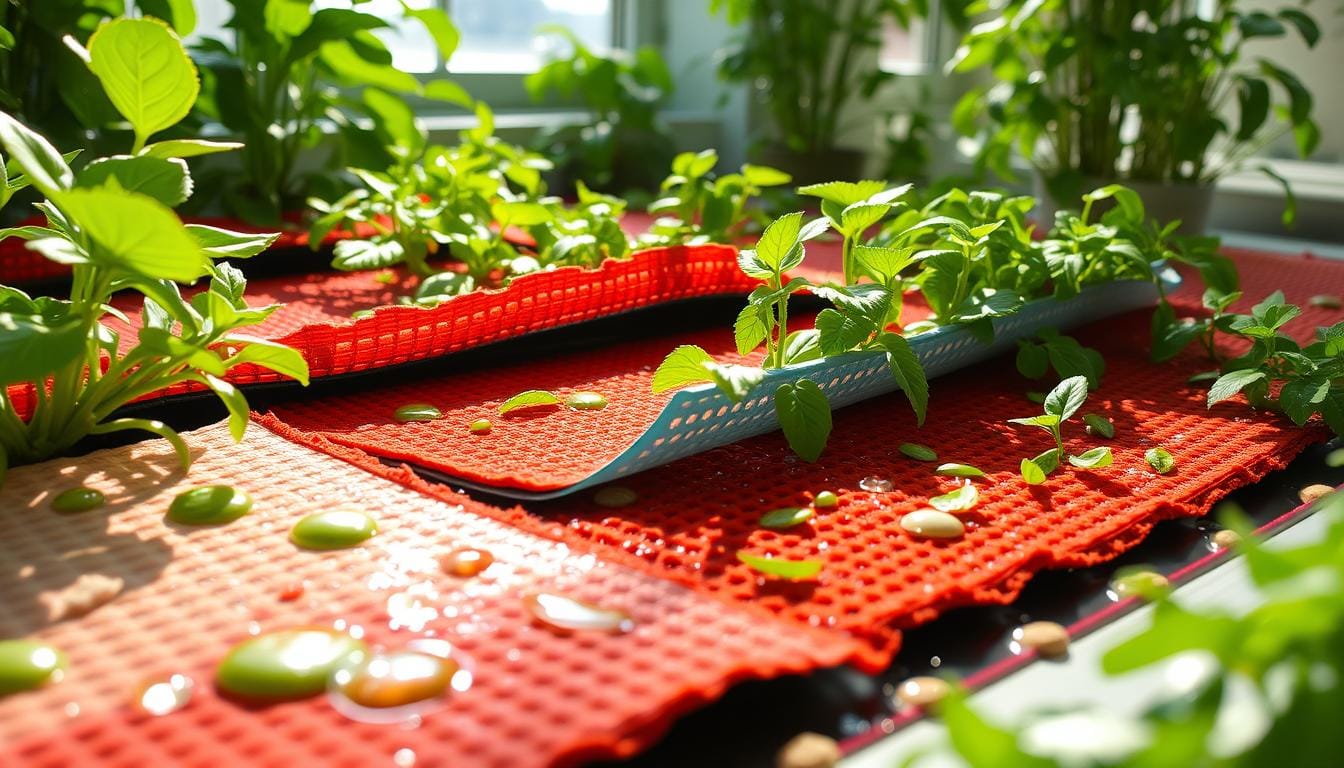I love growing plants indoors without soil. It’s amazing to have fresh herbs and greens all year. The key to this is the hydroponic mats, which are crucial for plant growth.
In this article, we’ll look at the top 5 hydroponic mats. They can make your indoor garden grow better. These mats are great for both new and experienced gardeners.
Key Takeaways
- Hydroponic mats are essential for indoor gardening, supporting plant growth without soil.
- They offer affordability, accessibility, and space efficiency for growing herbs, leafy greens, and other plants.
- Hydroponic systems typically cost between $300 to $1000, with an average of $650, making them a viable option for many indoor gardeners.
- These mats enable year-round cultivation and are suitable for various plants, including basil, parsley, thyme, and cilantro.
- Choosing the right hydroponic mat can significantly impact the success and productivity of your indoor garden.
Understanding Hydroponic Mats and Their Role in Indoor Gardening
Hydroponic mats are key in indoor gardening. They help plants grow well by giving roots a stable place to thrive. These mats offer many benefits that help your hydroponic system succeed.
How Hydroponic Mats Support Plant Growth
Hydroponic mats act like soil for plants. They let roots grow strong. These mats soak up water and nutrients, giving plants what they need to grow big and healthy.
Key Benefits of Using Growing Mats
- Improved water retention: Hydroponic mats hold onto water well. This stops waterlogging and keeps roots moist.
- Enhanced nutrient distribution: Mats made of nylon or polyester spread nutrients evenly. This helps plants get what they need.
- Increased oxygen access: The mats’ design lets air in. This ensures the roots receive the oxygen necessary for healthy growth.
Material Composition and Durability Factors
Hydroponic mats are made from strong fibers like nylon and polyester. These materials can handle being wet and full of nutrients all the time. They stay strong and work well for a long time.
| Material | Durability | Water Absorption | Nutrient Distribution |
|---|---|---|---|
| Nylon | High | Moderate | Excellent |
| Polyester | High | High | Good |
| Coconut Fiber | Moderate | High | Good |
Essential Features to Consider When Choosing Growing Mediums
Choosing the right growing medium is key for a successful indoor garden. Soilless cultivation has many benefits. But, picking the right medium is crucial. Here are important features to look for in a growing medium for your hydroponic setup:
- Water Retention Capacity: The medium should hold moisture well. This ensures your plants get water consistently without getting too wet.
- Nutrient Holding Ability: It should keep and release nutrients like nitrogen, phosphorus, and potassium. These are vital for plant growth.
- pH Stability: The medium should keep a stable pH, usually between 5.5 and 7.0. This is best for hydroponic herbs like basil and thyme.
- Air Porosity: It should have enough air pockets. This helps with root aeration and prevents root rot, a common problem in soilless gardens.
By thinking about these factors, you can pick a growing medium that’s perfect for your hydroponic plants. This will help them grow well and produce more.
“Choosing the right growing medium is crucial to the success of your indoor hydroponic garden.”
Whether you go for custom blends, potting soil, coconut coir, hemp mats, or Pro-Mix, the goal is to find the best medium. Understanding these features and choosing wisely will help your hydroponic garden thrive.
The Science Behind Capillary Mat Systems
Capillary mat systems use capillary action to spread water and nutrients. They have a wicking material that pulls water from a reservoir. This material spreads it evenly to plant roots.
By mixing nutrients into the water, these systems provide plants with what they need. This ensures plants get the essential elements they require.
Water Distribution Mechanisms
Capillary mat systems work by using capillary action. Water is drawn up through the wicking material. This creates a uniform moisture level for plants’ roots.
This method helps keep plants hydrated evenly. It prevents drying out and supports healthy growth.
Nutrient Delivery Technology
These systems mix nutrients directly into the water reservoir. As water is pulled up, it carries the necessary minerals and elements. This makes it easy and reliable for indoor gardeners.
Root Development Support
The system supports healthy root growth. It offers the perfect balance of moisture and airflow. This helps roots spread and absorb what they need for strong growth.
This foundation ensures your indoor garden can reach its full potential.
“Effective water management, including bottom watering, monitoring moisture levels, and using advanced irrigation techniques, can enhance microgreens growth and promote healthy root development.”
Best Materials for Hydroponic Mats in Indoor Gardens
Choosing the right hydroponic mats is key for a great indoor garden. They help plants grow well and increase yields. Look for mats made from synthetic and natural fibers. These materials are durable, hold water well, and fight off mold and bacteria.
Synthetic fibers like polyester and nylon are top picks. They’re strong and last a long time. You can clean them often without worry. Some mats are made from natural fibers such as jute or bamboo, which enhance water absorption and support strong root growth.
- Polyester and nylon mats offer superior durability and resistance to mold and bacteria.
- Natural fibers like jute and bamboo can improve water retention and root support.
- High-quality mats often feature a multi-layer design, combining different materials to optimize water distribution and root growth.
- Look for UV-resistant materials that can withstand the demands of indoor gardening environments.
When picking hydroponic mats, think about your plants’ needs and your garden’s setup. The right choice will help your indoor farm grow strong and healthy. This way, you’ll get the most from your plants.
| Hydroponic Mat Material | Key Benefits | Drawbacks |
|---|---|---|
| Polyester | Durable, resistant to mold and bacteria, easy to clean | May not be as water-absorbent as natural fibers |
| Nylon | Highly durable, strong tensile strength, resistant to wear and tear | Can be less breathable than other materials |
| Jute | Excellent water absorption, biodegradable, sustainable | May be more prone to mold and decomposition over time |
| Bamboo | Renewable, biodegradable, good water-holding capacity | Can be less durable compared to synthetic options |
“Choosing the right hydroponic mat is key to establishing a thriving indoor garden. By choosing the best materials, you can ensure your plants receive the optimal growing conditions for maximum yields.”
Optimizing Your Indoor Garden Setup with Professional Grow Mats
Choosing the right growing medium is key for a thriving indoor garden. Professional hydroponic grow mats are a top choice for better plant growth. Knowing how to control the environment and maintain your setup can help your plants thrive.
Environmental Control Techniques
Keeping the temperature and humidity right is vital for your plants. Herbs and greens generally grow best in temperatures ranging from 18-24°C (65-75°F). Make sure they get 10-16 hours of light daily, based on their needs. Also, good airflow is important, and Clip-On Fans can help keep things steady in your grow tent.
Maintenance Best Practices
- Keep your grow mats clean to stop algae buildup, which hurts system efficiency.
- Make sure water drains well to avoid root rot and other problems.
- Check the pH of your nutrient solution and adjust it to keep it right for your plants.
System Integration Guidelines
Linking your grow mats with a good irrigation system is key for your plants’ needs. Think about using Adjustable Rope Hangers for your grow lights. Also, Humidity and Temperature Monitors help you keep an eye on important factors for your garden.
Using these tips and the right tools can make your indoor garden flourish. A well-designed and cared-for system is the base for a successful and sustainable garden.
“Investing in the right accessories can boost plant growth, improve efficiency, and offer better control over the growing environment.”
Comparing Different Types of Soilless Growing Mediums
Choosing the right growing medium is key for indoor gardening success. Soilless cultivation offers many options, each with its own benefits. These benefits include water retention, aeration, and nutrient delivery. Let’s look at some top soilless growing mediums and their fit for hydroponic mats.
Rockwool is a favorite for its drainage and aeration. It’s great for herbs and leafy greens. Coco coir, made from coconut husks, holds water and nutrients well. It’s perfect for many plants. Perlite improves drainage and aeration, while hydroponic mats ensure even moisture. They’re perfect for growing herbs and leafy vegetables.
When picking a growing medium, think about reusability, environmental impact, and system compatibility. Hydroponic mats are known for their sustainability and easy setup. They’re a favorite among indoor gardeners.
| Growing Medium | Key Benefits | Suitability for Hydroponic Mats |
|---|---|---|
| Rockwool | Excellent drainage and aeration | Suitable for herbs and leafy greens |
| Coco Coir | Superior water-holding capacity and nutrient retention | Suitable for a variety of plants |
| Perlite | Improves soil drainage and aeration | Suitable for a range of hydroponic crops |
| Hydroponic Mats | Uniform moisture distribution, sustainability, and ease of integration | Highly suitable for growing herbs and leafy vegetables |
Knowing the special features of each soilless growing medium helps you choose wisely. This choice should match your hydroponic gardening goals and indoor setup needs.

Advanced Techniques for Maximum Growth Using Hydroponic Mats
Unlocking exceptional growth in your indoor garden is possible with hydroponic mats. Learn about temperature, humidity, nutrient solution, and pH to make your hydroponics setup thrive. Watch your plants grow like never before.
Temperature and Humidity Control
Keeping the right temperature is key for your plants’ health. For example, basil loves 21-27°C, while chives do best at 18-24°C. Adjust your indoor climate to meet your hydroponics crops’ needs. Also, keep humidity levels right to avoid mold and fungal problems that can harm crop propagation and indoor farming.
Nutrient Solution Management
The nutrient solution is vital for your hydroponic system. Check the electrical conductivity (EC) levels often. This ensures the right amount of nutrients. Adjust the solution based on your plants’ growth stage for the best nourishment.
pH Level Optimization
Keeping the pH range between 5.5-6.5 is essential for most herbs. This range helps with nutrient uptake and prevents lockout. Test and adjust the pH levels regularly to create the best growing environment for your indoor farming.
Mastering these advanced techniques will unlock your hydroponic mats’ full potential. With focus on temperature, humidity, nutrient management, and pH, your hydroponics setup will flourish. It will become a powerhouse of growth and productivity.
Troubleshooting Common Issues with Growing Mats
rowing your own indoor garden with hydroponic mats is highly rewarding, but it also comes with its own set of challenges. Knowing how to spot and fix common problems with your growing mats is crucial for a healthy indoor garden.
One big issue is uneven water distribution on the mat. This can cause some spots to be too wet while others are too dry. Make sure your mats are level and in the right spot. Also, using covers to block light can stop algae from growing, which helps the mat work better.
Salt buildup is another problem. Nutrient solutions can leave behind minerals that clog the mat. Clean water flushes out these salts, keeping your soilless cultivation system working well.
Watch for signs of root rot or nutrient deficiencies. If leaves are discolored or plants are wilting, you might need to adjust how often you water or the nutrient levels. By keeping an eye out and making changes as needed, your hydroponic mats will support your plants’ growth.
Finally, replace your mats when they start to break down or lose their water and nutrient delivery ability. Even the toughest mats will eventually wear out. Replacing them keeps your indoor gardening setup at its best.
“Troubleshooting issues with your growing mats is all about maintaining a keen eye and a willingness to make adjustments as needed. With the right approach, you can keep your indoor garden thriving for years to come.”
By tackling common problems and keeping up with mat care, you can get the most out of your hydroponic mats. This will help you create a lush, productive indoor garden that will feed you for many seasons.

Cost-Benefit Analysis of Different Mat Systems
Choosing the right growing mats for your indoor hydroponic garden is key. It affects your initial costs and ongoing expenses. Knowing the pros and cons of different mat systems helps make your indoor farming project work financially.
Initial Investment Considerations
Setting up a hydroponic system can be expensive. You need special equipment like growing mats, irrigation systems, and structures. The size of your garden, mat quality, and system complexity all play a role in costs. For instance, advanced systems like capillary mats or aeroponics might cost more than basic setups.
Long-term Operation Costs
After the initial setup, ongoing costs are important. These include replacing mats, buying nutrient solutions, and energy for pumps, lights, and climate control. The durability and efficiency of your mat system greatly affect these costs. It’s vital to think about these trade-offs carefully.
Return on Investment Factors
Calculating the return on investment (ROI) for your hydroponic garden involves several factors. Hydroponic systems, especially those with advanced mats, can produce more and grow faster than traditional farming. This can lead to higher profits, helping to cover costs.
By considering initial costs, ongoing expenses, and potential earnings, you can choose the best hydroponic mat system. Finding the right balance between cost and efficiency is crucial for your indoor garden’s success and profitability.
| Metric | Aeroponics | Hydroponics |
|---|---|---|
| Water Usage | Up to 95% less than soil-based agriculture | Requires less water than soil-based farming |
| Pest and Disease Risk | Lower risk due to absence of soil | Lower risk compared to soil-based farming |
| Nutrient Delivery Efficiency | Higher due to enhanced oxygen exposure | Generally higher than soil-based farming |
| Initial Setup Costs | Higher due to specialized equipment | Can be high but more accessible for beginners |
| Operational Costs | Higher due to sophisticated misting equipment | Generally lower than aeroponics |
Conclusion
Hydroponic mats are a great way to grow plants indoors. They save space and help plants grow well. You can grow everything from herbs to leafy greens on these mats.
These mats keep plants moist and give them nutrients. This helps roots grow strong and plants grow well. By choosing the right mats and taking good care of them, you can grow plants all year.
Understanding how hydroponic mats work is key. They use capillary action to feed plants. Choosing the right materials is also important for a good indoor garden.
With the right setup, like the Spider Farmer Smart G12, you can grow a lot of food indoors. This way, you can have a garden full of fresh, healthy food right in your home.
Using hydroponic mats can change how you garden indoors. You can cultivate a variety of plants in a compact space. By taking care of your plants and keeping the right conditions, you can have a big harvest.
Starting your hydroponic garden can be exciting. It lets you grow food without using a lot of water or harmful chemicals. Begin your hydroponic journey today and see how it can change your indoor garden.

